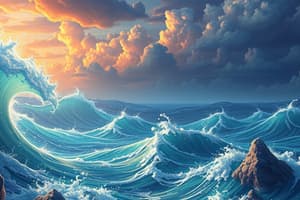Podcast
Questions and Answers
What factors contribute to the formation of ocean currents?
What factors contribute to the formation of ocean currents?
Ocean currents are driven by wind, density differences due to temperature and salinity variations, gravity, and events like earthquakes or storms.
What is the cryosphere, and how does it influence global climate?
What is the cryosphere, and how does it influence global climate?
The cryosphere consists mainly of sea ice in polar regions, helping to regulate climate by reflecting sunlight and minimizing heat absorption.
Describe how convection currents and slab pull work together in plate tectonics.
Describe how convection currents and slab pull work together in plate tectonics.
Convection currents move mantle material upward, driving plate movements, while slab pull occurs when denser plates slide beneath lighter ones at convergent boundaries.
How do El Niño and La Niña events influence global weather patterns?
How do El Niño and La Niña events influence global weather patterns?
Signup and view all the answers
Why are ocean currents vital for climate regulation on Earth?
Why are ocean currents vital for climate regulation on Earth?
Signup and view all the answers
Study Notes
Ocean Currents
- Ocean currents are driven by wind, density differences from temperature and salinity, gravity, and seismic events like earthquakes.
- Variations in water temperature and salinity cause density differences, influencing water movement.
- Currents play a significant role in regulating the global climate by distributing heat around the planet.
Cryosphere
- The cryosphere consists mainly of sea ice found in the Arctic and Southern Oceans.
- Reflective properties of ice and snow help maintain global temperatures by reflecting solar energy back into space.
- The cryosphere impacts global climate and weather patterns by influencing sea levels and thermal dynamics.
Properties of Water
- Water exhibits high polarity, contributing to its unique chemical reactivity and solvent abilities.
- High specific heat allows water to absorb a large amount of heat without significant temperature changes, stabilizing climates.
- Water's high heat of vaporization enables cooling effects during evaporation, which is crucial for temperature regulation.
- Lower density in its solid form (ice) allows it to float, creating insulating layers on aquatic environments.
Energy Flow and Plate Movement
- Convection currents in the Earth's mantle are driven by heat and pressure, causing magma to move and influence tectonic plate dynamics.
- Gravity affects plate movement by causing denser plates to subduct beneath lighter plates when they collide.
Contributions to Plate Movement
- Convection currents push mantle materials upward, feeding into the movement of tectonic plates.
- Slab pull occurs when denser oceanic plates sink into the mantle, pulling trailing plates along due to gravity.
El Niño and La Niña Events
- El Niño disrupts atmospheric circulation in the equatorial Pacific, shifting mid-latitude jet streams and affecting weather globally.
- La Niña reflects the opposite phase, enhancing trade winds and cooling sea surface temperatures, leading to distinct weather patterns.
Importance of Ocean Currents
- Ocean currents are essential for regulating global climate, balancing heat distribution from uneven solar radiation across Earth’s surface.
- They influence climatic patterns, marine ecosystems, and weather phenomena, including storms and precipitation distribution.
Studying That Suits You
Use AI to generate personalized quizzes and flashcards to suit your learning preferences.
Description
Explore the driving factors behind ocean currents and the significance of the cryosphere in regulating global climate and weather patterns. This quiz addresses key concepts such as temperature, salinity, and the reflective properties of ice and snow.




